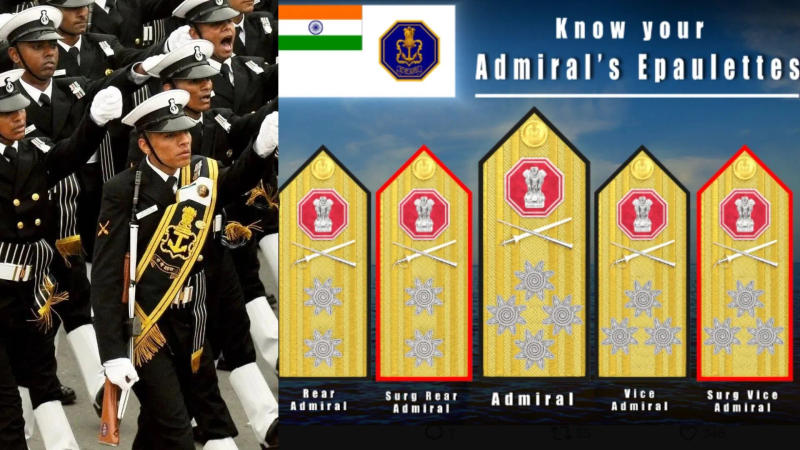Published 12:44 IST, December 29th 2023
Indian Navy unveils Shivaji’s Rajmudra-inspired epaulettes, embraces indigenous heritage in ranks
Indian Navy transitioned to indigenous designs, revealing Rajmudra-inspired epaulettes, and is also set to redefine sailor ranks by discarding colonial symbols

New Delhi:The Indian Navy has unveiled a new design for the epaulettes, ornamental shoulder pieces used as insignia of rank by its officers, drawing inspiration from the Rajmudra of Chhatrapati Shivaji. These were revealed by Prime Minister Narendra Modi during his Navy Day address on December 4 in Sindhudurg, Maharashtra.
The redesigned epaulettes are specifically designed for the ranks of Admiral, Vice Admiral, and Rear Admiral, which represent the top three positions in the naval forces.

Shifting from colonial symbols to embrace Indian heritage
This move to change the design of the epaulettes reflects the already ongoing effort to move away from symbols of colonial legacy. The current epaulettes feature Nelson's Ring, serving as a reminder of the colonial era. The new design, inspired by the maritime legacy of the Maratha ruler Shivaji Maharaj, aims to break free from this reminder of the past. Similarly, Prime Minister Modi had previously announced changes in naval traditions, including discontinuing the use of batons for commanders, adopting a new ensign, and permitting traditional Indian attire in officers' mess. These efforts collectively signify a step toward embracing and showcasing India's rich cultural heritage within its military institutions.
The Indian Navy stated, 'The Indian Navy proudly unveils the new Design of Admirals' Epaulettes. Announced by Prime Minister Narendra Modi during Navy Day 2023 at Sindhudurg - the new Design is drawn from the Naval Ensign & inspired by Rajmudra of Chhatrapati Shivaji Maharaj, and is a true reflection of our rich maritime heritage.'
Symbolism in the new epaulettes

The new shoulder pieces hold symbolic importance in their various elements.
- The golden navy button signifies the resolve to move away from a mentality associated with slavery. The navy said, ‘It reiterates our resolve to do away with Ghulami ki Maansikta.’
- The octagon shape represents the eight cardinal directions, symbolising a comprehensive and long-term vision.
- The inclusion of an Indian sword highlights the Navy's core purpose: to be at the forefront of national power and to triumph in conflicts by dominating adversaries and surmounting challenges. The Navy added, “it emphasises the very essence of our raison d'etre, viz. to be the cutting edge of national power and win wars through dominance, defeating adversaries, and overcoming every challenge.’
- Additionally, the telescope symbolises foresight, a long-term vision, and vigilance in an 'ever-changing' world.
Revamping sailor ranks and aligning with Indian traditions
Not only has the design of the epaulettes changed, but there are also plans to revise the ranks held by sailors, which were previously inherited from the British. According to reports, over 65,000 sailors are expected to receive new ranks aligned with Indian traditions. These new designations include Master Chief Petty Officer Ist Class, Master Chief Petty Officer IInd Class, Chief Petty Officer, Petty Officer, Leading Seaman, Seaman Ist Class, and Seaman IInd Class.
This initiative to Indianize the ranks and designs within the Navy is part of a broader effort to discard colonial military traditions. The changes extend beyond mere symbolism, as they aim to reinforce the Indian heritage and identity within the country's armed forces.
Updated 13:34 IST, December 29th 2023




